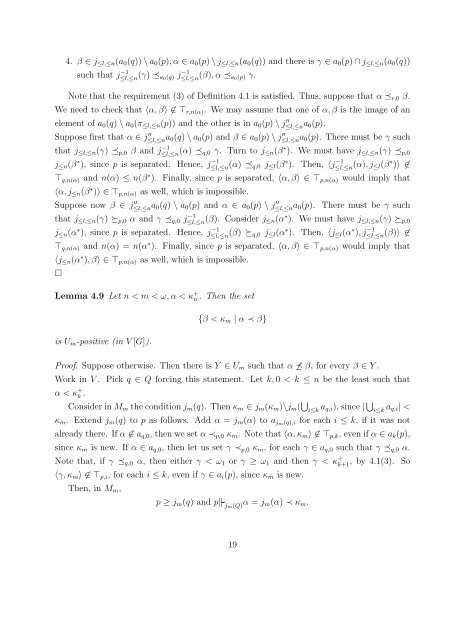On changing cofinality of partially ordered sets
On changing cofinality of partially ordered sets
On changing cofinality of partially ordered sets
Create successful ePaper yourself
Turn your PDF publications into a flip-book with our unique Google optimized e-Paper software.
4. β ∈ j ≤l,≤n (a 0 (q)) \ a 0 (p), α ∈ a 0 (p) \ j ≤l,≤n (a 0 (q)) and there is γ ∈ a 0 (p) ∩ j ≤l,≤n (a 0 (q))<br />
such that j −1<br />
≤l,≤n (γ) ≼ a 0 (q) j −1<br />
≤l,≤n (β), α ≼ a 0 (p) γ.<br />
Note that the requirement (3) <strong>of</strong> Definition 4.1 is satisfied. Thus, suppose that α ≼ r,0 β.<br />
We need to check that 〈α, β〉 ∉ ⊤ r,n(α) . We may assume that one <strong>of</strong> α, β is the image <strong>of</strong> an<br />
element <strong>of</strong> a 0 (q) \ a 0 (π ≤l,≤n (p)) and the other is in a 0 (p) \ j ′′ ≤l,≤n a 0(p).<br />
Suppose first that α ∈ j ′′ ≤l,≤n a 0(q) \ a 0 (p) and β ∈ a 0 (p) \ j ′′ ≤l,≤n a 0(p). There must be γ such<br />
that j ≤l,≤n (γ) ≼ p,0 β and j −1<br />
≤l,≤n (α) ≼ q,0 γ. Turn to j ≤n (β ∗ ). We must have j ≤l,≤n (γ) ≼ p,0<br />
j ≤n (β ∗ ), since p is separated. Hence, j −1<br />
≤l,≤n (α) ≼ q,0 j ≤l (β ∗ ). Then, 〈j −1<br />
≤l,≤n (α), j ≤l(β ∗ )〉 ∉<br />
⊤ q,n(α) and n(α) ≤ n(β ∗ ). Finally, since p is separated, 〈α, β〉 ∈ ⊤ p,n(α) would imply that<br />
〈α, j ≤n (β ∗ )〉 ∈ ⊤ p,n(α) as well, which is impossible.<br />
Suppose now β ∈ j ′′ ≤l,≤n a 0(q) \ a 0 (p) and α ∈ a 0 (p) \ j ′′ ≤l,≤n a 0(p). There must be γ such<br />
that j ≤l,≤n (γ) ≽ p,0 α and γ ≼ q,0 j −1<br />
≤l,≤n (β). Consider j ≤n(α ∗ ). We must have j ≤l,≤n (γ) ≽ p,0<br />
j ≤n (α ∗ ), since p is separated. Hence, j −1<br />
≤l,≤n (β) ≽ q,0 j ≤l (α ∗ ). Then, 〈j ≤l (α ∗ ), j −1<br />
≤l,≤n (β)〉 ∉<br />
⊤ q,n(α) and n(α) = n(α ∗ ). Finally, since p is separated, 〈α, β〉 ∈ ⊤ p,n(α) would imply that<br />
〈j ≤n (α ∗ ), β〉 ∈ ⊤ p,n(α) as well, which is impossible.<br />
□<br />
Lemma 4.9 Let n < m < ω, α < κ + n . Then the set<br />
is U m -positive (in V [G]).<br />
{β < κ m | α ≺ β}<br />
Pro<strong>of</strong>. Suppose otherwise. Then there is Y ∈ U m such that α ⋠ β, for every β ∈ Y .<br />
Work in V . Pick q ∈ Q forcing this statement. Let k, 0 < k ≤ n be the least such that<br />
α < κ + k .<br />
Consider in M m the condition j m (q). Then κ m ∈ j m (κ m )\j m ( ⋃ i≤k a q,i), since | ⋃ i≤k a q,i| <<br />
κ m . Extend j m (q) to p as follows. Add α = j m (α) to a jm (q),i for each i ≤ k, if it was not<br />
already there. If α ∉ a q,0 , then we set α ≺ p,0 κ m . Note that 〈α, κ m 〉 ∉ ⊤ p,k , even if α ∈ a k (p),<br />
since κ m is new. If α ∈ a q,0 , then let us set γ ≺ p,0 κ m , for each γ ∈ a q,0 such that γ ≼ q,0 α.<br />
Note that, if γ ≼ q,0 α, then either γ < ω 1 or γ ≥ ω 1 and then γ < κ + k+1<br />
, by 4.1(3). So<br />
〈γ, κ m 〉 ∉ ⊤ p,i , for each i ≤ k, even if γ ∈ a i (p), since κ m is new.<br />
Then, in M m ,<br />
p ≥ j m (q) and p‖ jm (Q) α = j m(α) ≺ κ m .<br />
19
















